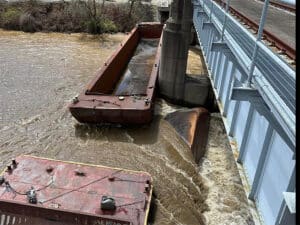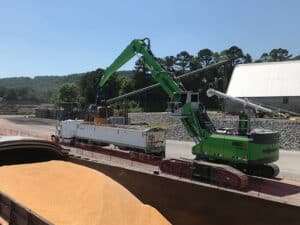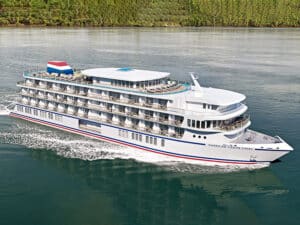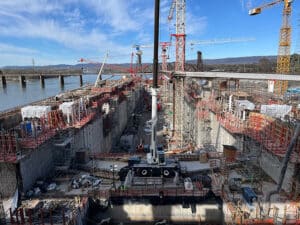
Port and Harbor Cranes Expand Shipping Capabilities
Written by Heather Ervin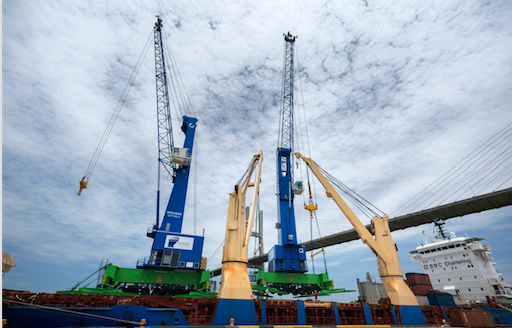
The first of two mobile harbor cranes is offloaded at the Port of Savannah’s Ocean Terminal, June 30, 2020. Two new mobile harbor cranes will allow the Georgia Ports Authority to grow container-handling services on the 200-acre facility. The cranes arrived by barge and were offloaded June 30 and July 1.
“Green Hybrid” Energy Savings
The reason for the cost savings is the distinctive Green Hybrid energy re-capture system engineered into the 895’s boom hydraulics. A pair of large hydraulic cylinders is mounted to either side of the main lifting cylinders. On each down stroke of the boom, the Green Hybrid cylinders hydraulically compress the gas in the storage modules at the rear of the upper carriage. On the next lift cycle, the compressed gas is released to give the lift cylinders a power assist, effectively offsetting the boom’s own weight, much as a compressed spring generates energy when it’s released. As a result, the re-capture system saves up to 55% of the energy for every lift, all day long.
The operator’s viewpoint from the elevated cab is ideal for loading and unloading bulk goods deep inside ships’ hulls. Cameras mounted behind and on the right-hand side of the cab provide the operator with the 360-degree view of the entire work zone, allowing faster cycle and travel time, safely. Sennebogen also offers a third camera location on the business end of the stick, near the grapple, for direct view inside holds, hoppers and other conveyor equipment.
Record Crane Assembly For E-Crane
Assembling an E-Crane, headquartered in Belgium with a U.S. office in Ohio, usually take three to four weeks. In a record-setting display of teamwork, a team of 10 people from E-Crane and maritime construction company Weeks Marine, Cranford, N.J., took only six days to assemble two of them.
The mechanical assembly was completed at North American Aggregates (NAA), a division of Weeks Marine that has a permit to dredge sand off the Lower New York Bay. The assembly benefitted from the use of Weeks Marine’s No. 533 floating crane, the largest on the East Coast.
The hoppers and conveyor are now in operation and the E-Cranes are unloading the Weeks dredge Eleanor on a regular basis. NAA processes the sand ashore into materials for the construction industry.
E-Crane CEO Steve Osborne had high praise for Weeks Marine’s crews. He credits the swift assembly to proper preparation and a meshing of expertise. “Not all of our customers have the same level of experience with heavy lift as Weeks Marine does, especially from a floating platform,” he said. “But Weeks is a specialist in heavy lift, like we are. They live and breathe it 24 hours a day.”
It’s the first E-Crane for Weeks, but things went so well between the two companies that both agreed it probably won’t be the last. Osborne said Weeks is considering new equipment on several other platforms.
Condition Based Maintenance Management
In addition to ship’s cranes, the product line of cargo and load handling solutions specialist MacGregor also includes small- and medium-sized port cranes. Against the background of the COVID-19 pandemic, MacGregor is seeing increased interest in condition-based information as owners and operators realize the benefits of original equipment manufacturer support in the digital age.
“As an industry, we are moving towards predictive tools, which will help to eliminate unplanned downtime, ultimately reduce maintenance costs and increase revenue and profitability,” says Dennis Mol, vice president, digital and business transformation at MacGregor, which is a part of Cargotec headquartered in Helsinki, Finland.
He says MacGregor’s extensive knowledge is being channeled into developing algorithms that can predict when certain equipment requires maintenance based on use and condition, rather than relying on conventional time-based service schedules. Digital advances in this arena include OnWatch Scout, with two merchant shipping and offshore pilot projects currently in operation and more awaiting installation.
“High quality, accurate, predictive maintenance is possibly one of the most important elements of service provision,” says Mol. “OnWatch Scout is a predictive tool developed to ensure that equipment is able to operate more or less continuously. It detects variations in the behavior of components and predicts if something might happen. We then have the ability to notify the customer and advise them of the preventative steps that need to be taken to avoid component failure.
“The crew and operation centers engaged in the pilot programs are very happy with the ease of system use and information being made available, which is providing common visibility of the crane operating information. This, in turn, is supporting effective ship to shore communication and coordinated decision making.”


